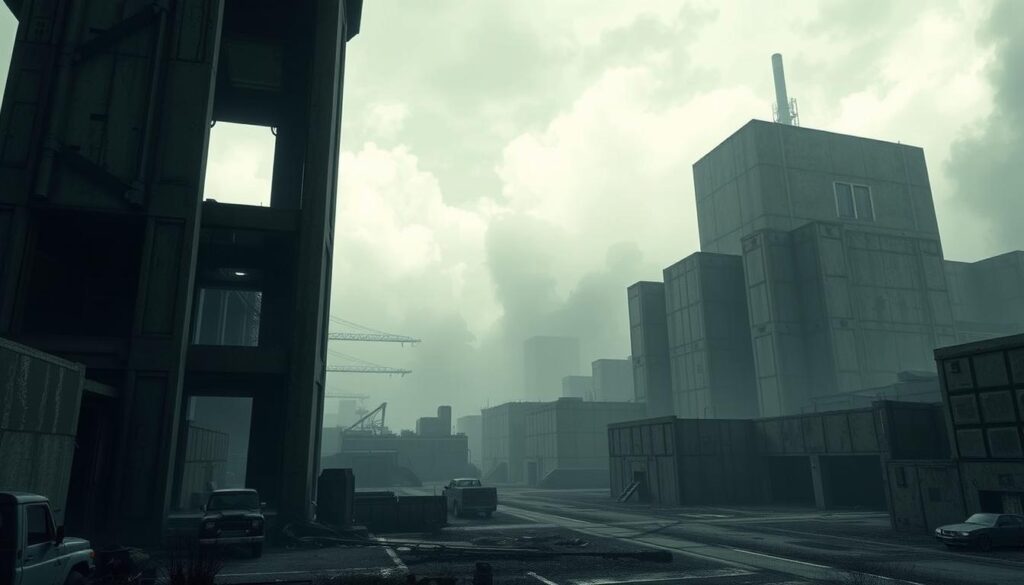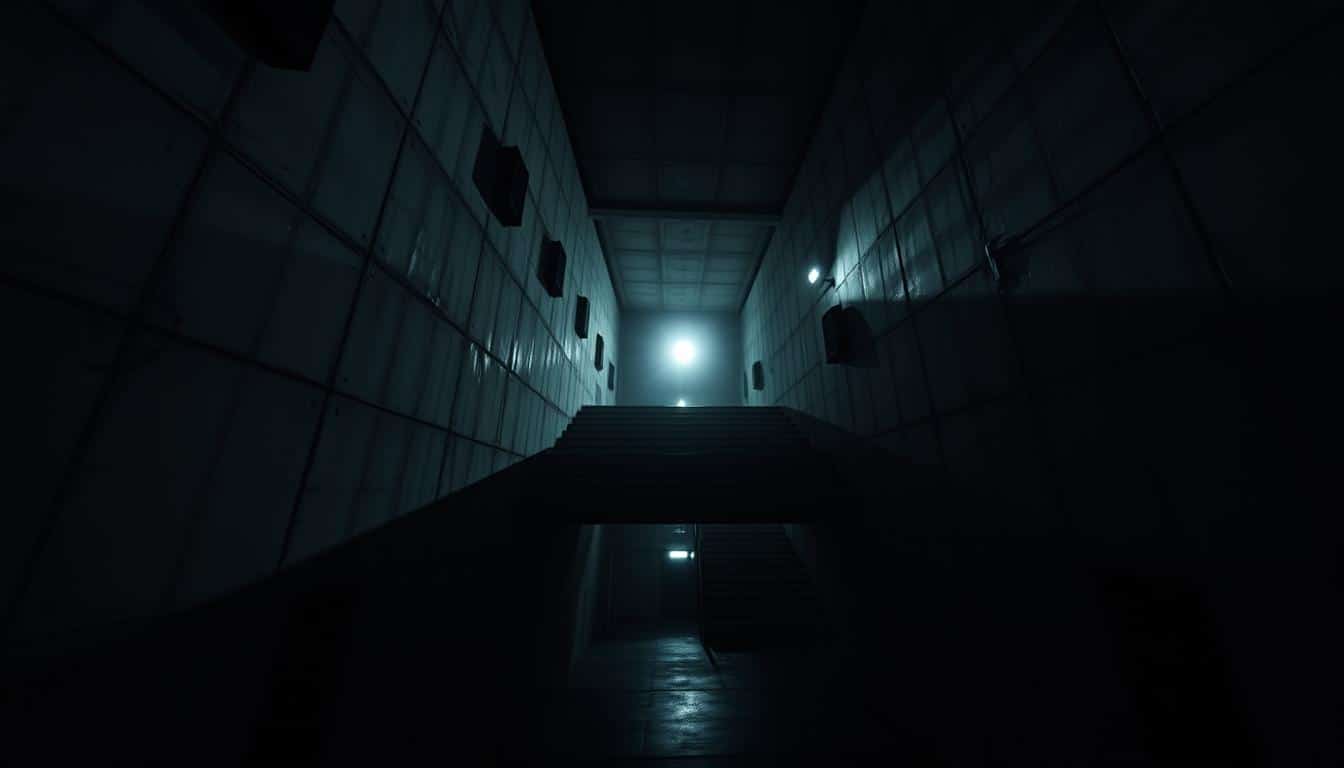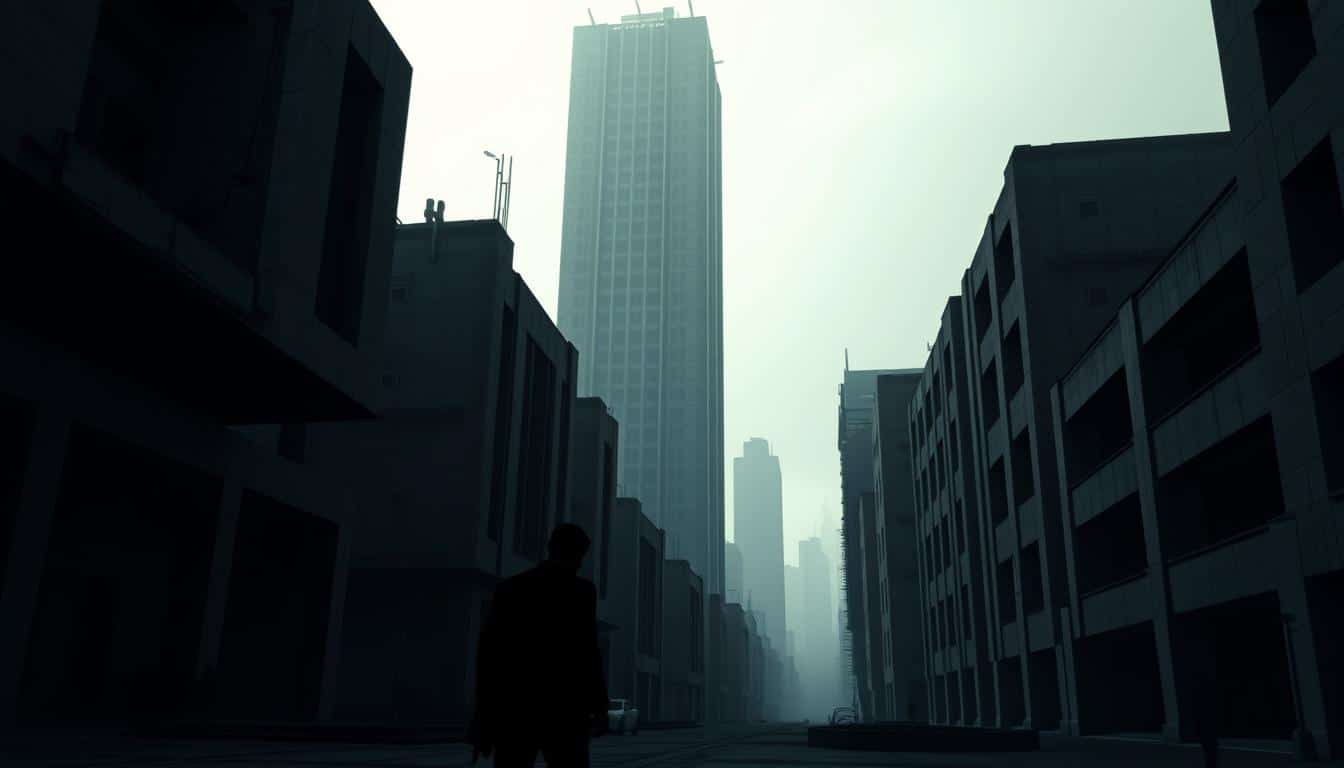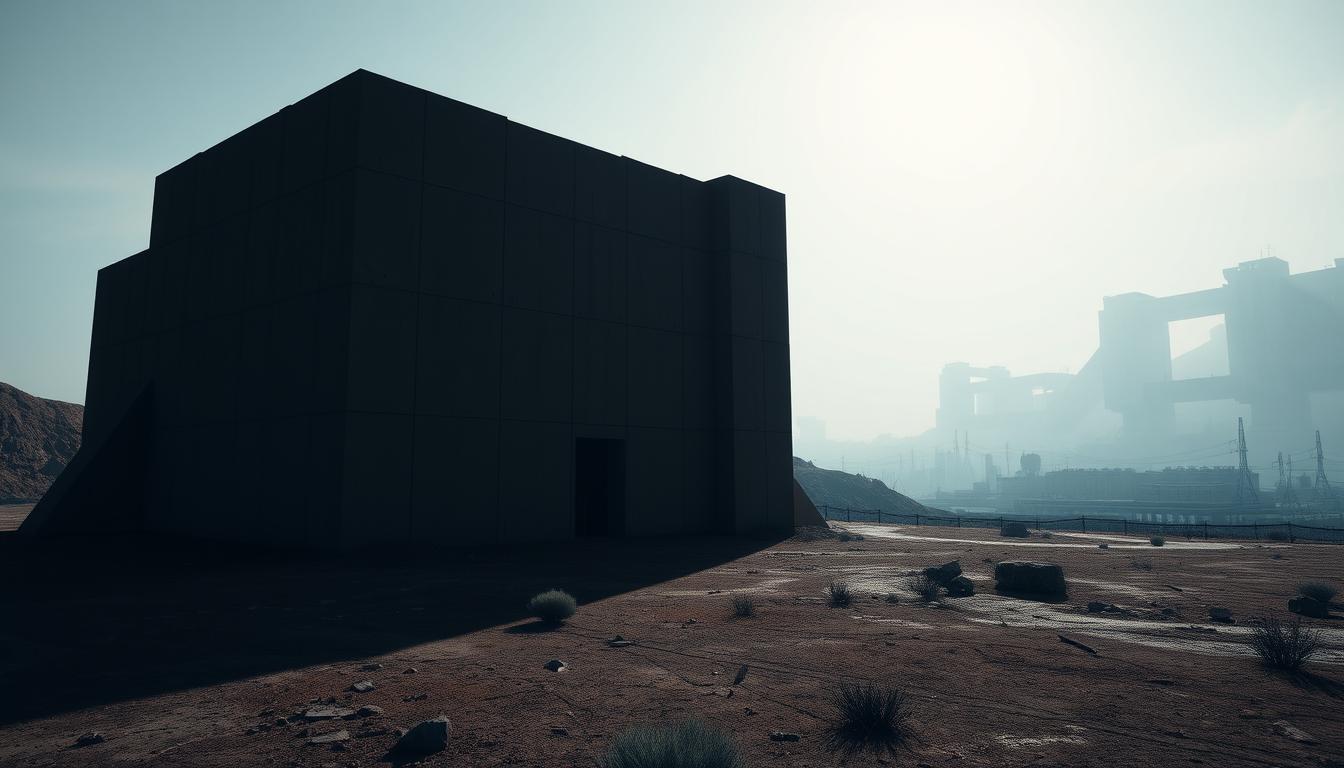Gaming is always changing, and a fascinating trend has appeared. It’s about how brutalism in games links to fear. This style, known for its bold, raw look, fits perfectly in horror games. Game makers use brutalist designs to make players feel more anxious and hooked.
We’re going to look at how brutalism and fear work together in games. Stark images and intense settings spark strong feelings. These elements don’t just make games fun; they also tell stories that stick with us. Let’s dive into this interesting mix and see how it affects our minds.
The Aesthetic of Brutalism in Gaming
Brutalist aesthetics have made a special spot in video game design. They stand out with their stark shapes and raw materials. This style is all about function, creating immersive worlds that feel oppressive, especially in horror games.
These environments can be big and empty. This makes players feel tiny and alone.
By using brutalist looks, game designers tell stories through the environment. The simple, heavy feel adds to a mood of strangeness and fear. It pulls players into the story more. Games with these designs make us feel something deep, making the game better.

Games that use brutalism make us feel scared and weak. They turn the game’s world into something almost alive. This deepens the story, dragging us into an eerie place. Here, every little detail adds to the big story.
The Origins of Brutalism
Brutalism started as a bold new architectural trend in the mid-20th century. It stood out from earlier styles with its focus on simplicity, functionality, and use of raw materials. Brutalism’s look is defined by concrete, big shapes, and geometric forms. People like Le Corbusier led the way with these designs. They were mostly used for practical buildings, such as homes for many people and public buildings. This showed a new way of thinking about city design.
Historical Context and Architectural Significance
In the middle of the 20th century, brutalism was making its mark with buildings that looked strong and lasting. The bare concrete used made a bold visual impact. Besides serving a practical purpose, these buildings played a role in the political and social issues of their time. They became important landmarks, showing the cultural impact of brutalism and how it changed cities.
Brutalism in Contemporary Culture
Lately, there’s been a renewed interest in brutalism among architects and artists. They see value in its honest and tough qualities. Brutalism is getting noticed again, leading to talks about its place in today’s designs. When used in city scapes today, it brings back old memories with a new twist. Sometimes it gets criticized. In video games, brutalism helps create deep, engaging worlds. These games use its style to bring out feelings of being alone and under stress. This comeback shows a move toward clearer design in society, with brutalism playing a big role in video game worlds.
Defining Fear in Gaming
Fear in video games comes from different elements that trigger strong emotions in players. Games that focus on psychological horror use storytelling and how the game’s world looks to make players feel scared and uneasy. They add unexpected dangers and the feeling of being alone in the game, making the fear feel even stronger.
How much control players have, and how vulnerable they feel, is key to making games scary. Giving players control but facing them with scary situations makes the game more real to them. This makes players feel more connected and scared, which is what makes video games so thrilling. This balance between control and fear pulls players in, making them eager to see what happens next.
The Role of Atmosphere in Horror Games
The atmosphere in horror games is crucial. It builds the tension that keeps players on their toes. By using light, colors, and the arrangement of spaces, game designers can make a game feel spooky. This creates a scary environment where players can really feel the chill of horror games.
Creating Tension through Environment
The setting of a game adds to its suspense. Developers use:
- Dark corridors and oppressive architecture
- Unexpected number of pathways to invoke uncertainty
- Textures that evoke decay and neglect
These choices make players more alert and engaged with the game world. An eerie setting is key in making the game feel scarier. It keeps players hooked on the story as it unfolds.
Sound and Visuals in Building Fear
Sound makes the visuals in horror games even scarier. Creepy sounds increase the player’s fear, alongside startling noises. When sound and sight work together, they create a scary experience that sticks with players. Elements such as:
- Whispers echoing through empty halls
- Sudden loud noises that disrupt relaxation
- Subtle shifts in background sounds that keep players alert
They make the game’s atmosphere feel more real and frightening. This way, players face their fears as they try to survive the game.
Connection between Brutalism and Fear in Gaming
In video games, brutalism links closely to the fear we feel during horror games. This stark style makes us feel scared and alone, perfect for horror settings. The big, heavy look of brutalist settings makes the game feel more creepy.
Examples of Brutalist Architecture in Games
Many games use brutalist design to connect structure and fear. In horror games like “Neon Struct” and Bloober Team’s creations, large concrete and unwelcoming spaces make us feel trapped. These games use their settings to make the horror feel real, tapping into our fears of being alone and anxious.
Psychological Impact of Brutalist Design
Brutalism in games really gets into our heads, making us feel small and exposed. Playing in these big, stark places, gamers often feel more scared. This design isn’t just for show; it makes the horror feel deeper, connecting the game to our fears.
Case Study: Bloober Team’s Influential Designs
Bloober Team is known for its unique horror video games. They excel in creating stories and settings that really get under your skin. Games like “Layers of Fear” and “The Medium” stand out. They blend stories and visuals in a way that draws players into their terrifying worlds.
The Medium and Layers of Fear
“The Medium” and “Layers of Fear” mix stories with scary images to pull you in deep. “Layers of Fear” takes you inside the mind of a troubled painter. Each corner turned reveals his dark memories. The game’s mood keeps you feeling uneasy, making the journey through it gripping.
These games make you face things that scare you. This makes the playthrough not just fun but also emotionally moving.
Elements of Brutalism in Cronos: The New Dawn
In “Cronos: The New Dawn,” Bloober Team uses a design style called brutalism to set a unique mood. The game’s buildings are inspired by Polish brutalism. This makes you feel alone and ups the scare factor. The way these games look messes with your sense of reality, taking horror to new levels.
As you explore the game’s world, fear and curiosity drive you forward. It’s a game experience where the fear feels all too real.
Comparative Analysis: Brutalism vs. Other Artistic Movements
Brutalism is known for its straightforward, raw look. However, movements like expressionism and surrealism provide a different view. They add emotional depth to horror game design. These styles help players dive into deeper psychological horror, creating engaging experiences.
Expressionism and its Role in Gaming Horror
Expressionist art shows feelings through exaggerated shapes and sharp contrasts. It’s important in horror games. Unlike brutalism, which focuses on structure, expressionism explores the deep emotions of characters. Games with expressionist themes use striking visuals and rich stories to spark fear and worry. This approach contrasts with brutalism’s cold look, creating a feeling of unease.
Surrealism in Video Game Design
Surrealism in games offers a unique horror approach by blending reality with the subconscious. It moves away from brutalism’s clear structures to explore strange, unknown areas. Surrealist elements scare players by upsetting what they expect, using dreamy sequences that make them question reality. These design choices deeply affect the player’s psyche. This makes surrealism vital for making original horror stories.
Player Experience: Emotions and Gameplay
Visual design is key in making players feel emotions in horror games. It shapes how players feel, often making them more scared. Developers work hard on visuals to make horror feel real and tell a scary story that sticks with you.
The Psychological Impact of Visual Design
In horror games, visuals are crucial for telling the story. They can make you feel scared just by looking at them. This makes the game more intense as players move through creepy places. Good visual design makes the game’s scary moments even more intense.
Engagement Through Immersive Environments
Great game environments make players want to explore more. Horror games use certain styles to make everything feel creepier. This pulls players in, making every scary moment feel even stronger. Great design in these games makes you more involved and enhances the fun.
Exploring the Future of Gaming Design
The future of gaming design is exciting. It combines old styles with new, eye-catching looks. Developers are exploring what design can do. They are using ideas from brutalism and more. This change shows they know that architecture can make stories better. It creates deep, engaging games that players love.
The gaming world is changing. Now, making games that touch players deeply is more important. Developers want games that grab you and make you feel something strong. They are using stories and worlds that make you think and feel.
New technology and creative ideas are shaping gaming’s future. They are blending beauty with how games work. These changes make games more about connecting with players and the art of making games. We’ll see games that are more lively and bold. They will go beyond what we usually see in games.
Conclusion
The connection between brutalist architecture and fear in video games shows how buildings influence our feelings. By studying the buildings in horror games, we learn that brutalism can really make a game feel scarier. This style of architecture doesn’t just make the game look a certain way; it also helps players dive deeper into the game world.
Today, as video games grow and change, adding different kinds of buildings, like brutalist ones, changes how games feel. Players get to explore places that challenge them and make them feel more emotions. This mix of fear and detailed buildings makes playing games a richer experience.
Talking about brutalism and fear helps us see how important design is in video games. Knowing how to blend these elements gives game makers the tools to create games that touch our emotions more deeply. Looking ahead, it’s clear that combining various architectural styles will keep changing the way stories are told in games.



